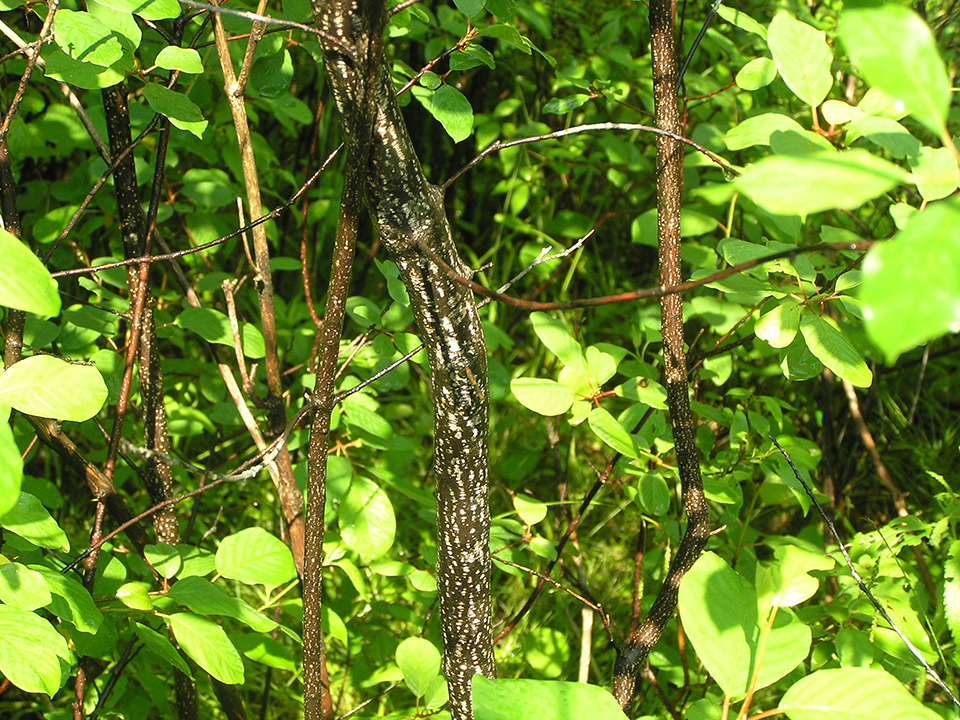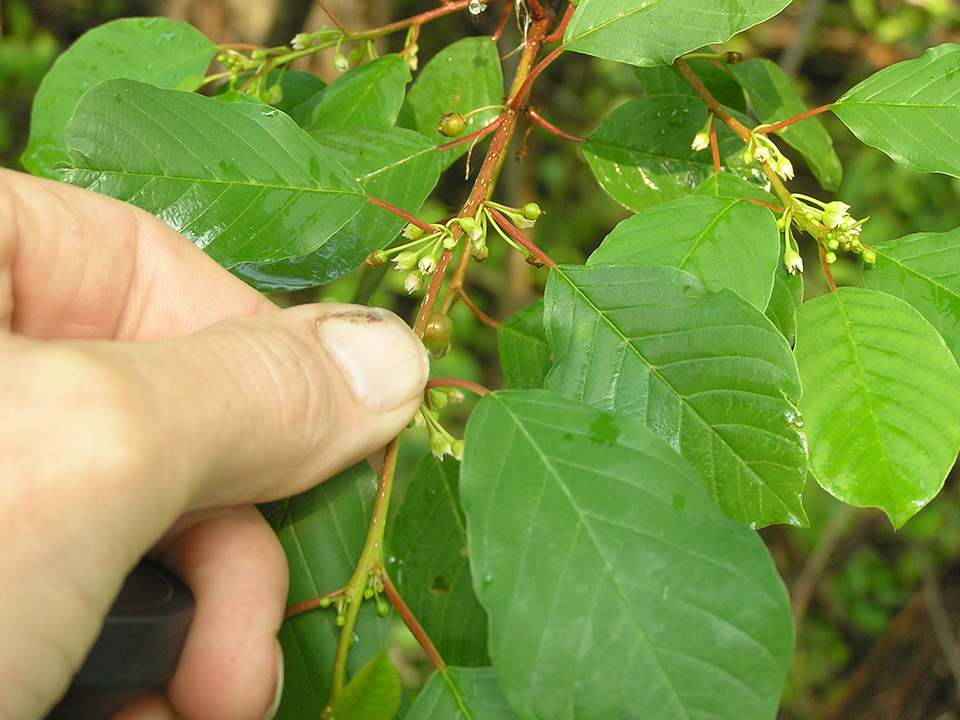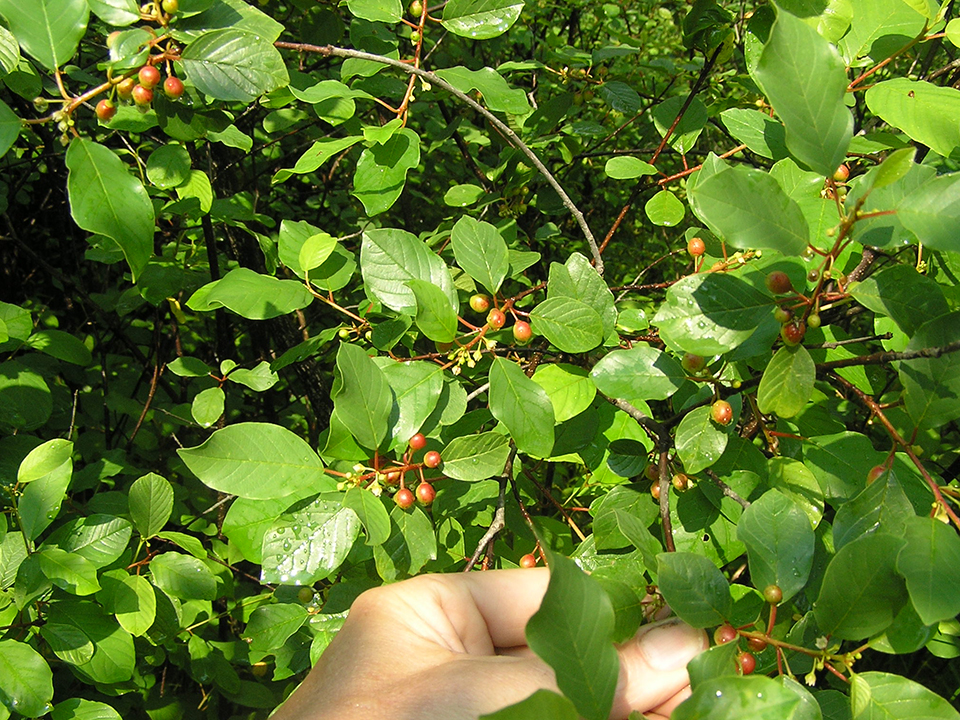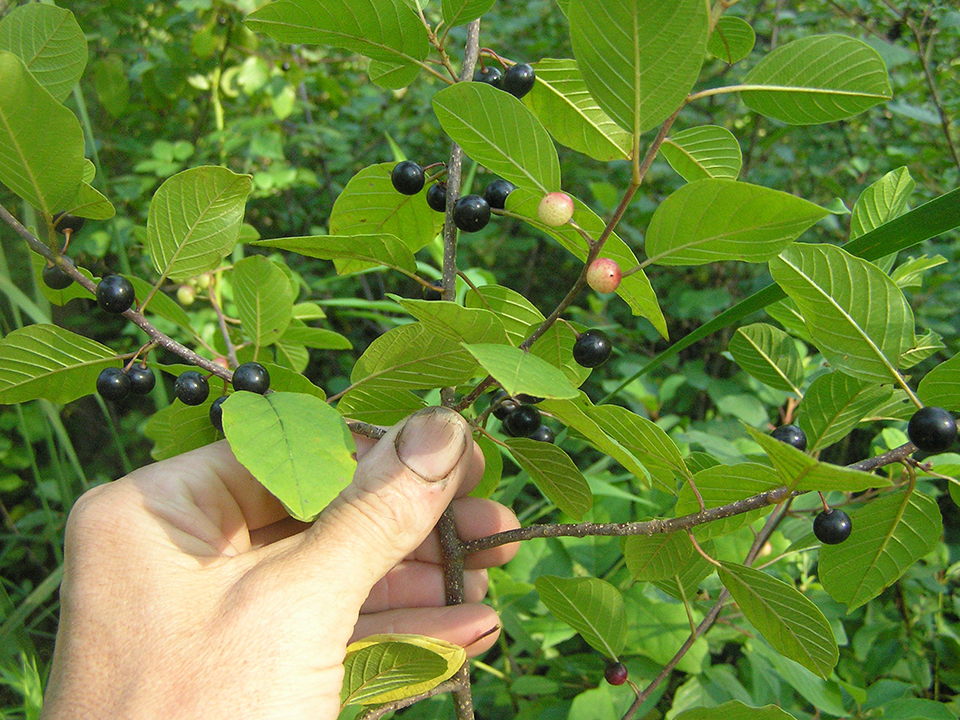
Diagnositc white lenticels covering the stems of young glossy buckthorn stems. Note glossy buckthorn does not have thorns. Stems are long, thin and flexible.
Species Name: Rhamnus frangula, sny. Frangula alnus
Common Name: Glossy buckthorn, Alder buckthorn
Origin: Northern Europe south to northern Africa west to Asia
Distribution: Found throughout the eastern US
Identification: Glossy buckthorn is a large shrub to small tree that grows to about 20 ft tall and can reach 6 to 8” in diameter. More typically stems range up to 5” diameter or smaller. The bark is brownish gray speckled with easily distinguished elongated, lighter areas called lenticels which is diagnostic. Bark is smooth with no spines unlike common buckthorn that has spines at the ends of the twigs. Stems of young trees are long, slender and flexible.
The sapwood (tissue just below the outer bark) of branches and the trunk is yellow and the heartwood (tissue in the center) is pink/orange.
Leaves do not change color in the fall and persist until cold or snow makes them fall. Fall is one of the best times to identify buckthorn as the leaves of nearly all native plants turn color while buckthorn leaves remain dark green providing easy identification.
Several small flowers are produced in the axil of each leaf. Flowers are not showy.
The fruit is a round drupe, about the size of a pea. Fruit can be found between July and September; it starts green, turns red, and then changes to dark purple/black as it ripens. Both ripe and unripe fruits may be present on the same tree.
Diagnostic characteristics:
Look for numerous white lenticels on bark.
Bark is reddish brown on young stems to grey brown on older stems. Only cherry trees have similar dark bark and could be misidentified for buckthorn, but cherry bark does not have the wide lenticels.
Wood and pith of buckthorn is a dull yellow to orange color on older wood.
Leaves stay green or turn slightly yellow before they senesce in early winter. There is no significant fall color.
The leaves grow alternately along branches, but may appear opposite toward the tips
The green foliage stands out against the backdrop of the fall color of native plants.
Dark black fruits on 1” stalks in the axils of each leaf.
Biology and Spread: Glossy buckthorn has the ability to germinate and grow in a variety of soil and light conditions making it a threat to nearly all habitats. It readily invades wetlands, swamps and wet habitats but just as easily invades drier sites colonizing old fields, hedgerows and forest edges. It is shade tolerant and can invade the forest interior.
Glossy buckthorn flowers and fruits at a young age and this contributes to its proliferation. Plants growing in full sun fruit earlier and more abundantly than those growing in shade. Plants continue to flower and fruit throughout late summer into fall.
Ecological threats: Buckthorn is very shade and moisture tolerant and readily colonizes marshes, swamps and the understory of damp woodlands. These areas are most at risk because they are seldom visited by people and the invasives are overlooked.
Glossy buckthorn leafs out early and drops its leaves late so it can out compete native vegetation. In woodlands, as buckthorn grows larger and its canopy spreads, it effectively intercepts all of the available sunlight reaching the ground. The ground layer becomes devoid of any vegetation save for numerous buckthorn seedlings.
High populations of deer have the effect of favoring the establishment of buckthorn as deer do not browse on buckthorn to any significant degree. Deer prefer to browse on native tree seedlings and shrubs impacting their growth but ignore buckthorn allowing it to out compete native plants. The combined impact of dense shade and deer herbivory has the affect of creating a biological dessert where few native plants can germinate and grow.
Control methods:
1) Cut Stump Treatment:
Cut stump treatment is one of the most efficient methods for controlling glossy buckthorn. The wood is weak and brittle and cuts easily. A forest clearing saw is extremely fast and effective for cutting single or multiple stems from 1” to 5” in diameter.
As buckthorn readily resprouts from the stump after cutting, the cut surface needs to be treated with a herbicide. A 10% to 15% solution of glyphosate (the active ingredient in Round-up) is applied to the cut surface. A hand held spray bottle works well for applying the herbicide to the cut stem. Add a spray colorant to the bottle so you can tell which stems have been treated.
Dense stands of buckthorn seedlings or small plants can be controlled using glyphosate as a foliar spray. Spray from mid summer through fall as long as the leaves are green and actively photosynthesizing.

Diagnositc white lenticels covering the stems of young glossy buckthorn stems. Note glossy buckthorn does not have thorns. Stems are long, thin and flexible.

Flowers and glossy leaves of glossy buckthorn. Flowers are produced in the leaf axils.

Developing glossy buckthorn fruit. Plants oftern have mature and immature fruit plus flowers all at the same time.

Mature dark black glossy buckthorn fruit. Fruit are produced individually on a 1" long stalk .